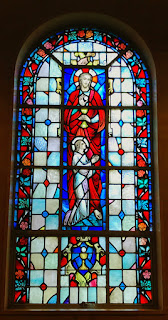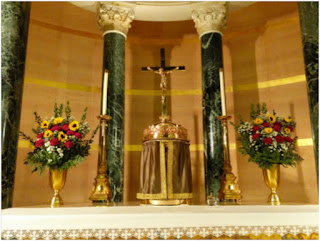In The Eucharist, Christ Loves You Now
 The main chapel at St. Mary’s seminary contains multiple
stained glass windows with different themes. On the left wall we find a set of
seven windows under the theme of the Seven Sacraments. One of these depicts the
sacrament of the Eucharist.
The main chapel at St. Mary’s seminary contains multiple
stained glass windows with different themes. On the left wall we find a set of
seven windows under the theme of the Seven Sacraments. One of these depicts the
sacrament of the Eucharist.
The artwork has three parts. The outer part is frame decorated
with organic elements, such as flowers and leaves. The inner part of the window
contains the image of Christ the Priest and a figure of a saint in adoration.
At the bottom we see a chalice and a Host. What can these elements tell us
about the theology of the Eucharist?
 St. Mother Teresa of Calcutta once said: “When you look at the crucifix, you understand how
much Jesus loved you then. When you look at the Sacred Host, you understand how
much Jesus loves you now.” The Eucharist is the source and summit of who we are
as Christians. It is the source of our apostolate and the strength in our
lives. The stained glass in the chapel reminds us of the great sacrament of
love that Jesus left us. We are continually invited to enter into communion
with God through prayer and find our rest and our strength in Him.
St. Mother Teresa of Calcutta once said: “When you look at the crucifix, you understand how
much Jesus loved you then. When you look at the Sacred Host, you understand how
much Jesus loves you now.” The Eucharist is the source and summit of who we are
as Christians. It is the source of our apostolate and the strength in our
lives. The stained glass in the chapel reminds us of the great sacrament of
love that Jesus left us. We are continually invited to enter into communion
with God through prayer and find our rest and our strength in Him. Christ is wearing priestly vestments with the liturgical color red. Red, as a liturgical color, symbolizes the shedding of blood and is used on Palm Sunday (his triumphant entry into the city Jerusalem to prepare for His death), Good Friday, and any other commemoration of the Lord’s passion, the votive Mass of the Precious Blood, and the feasts of martyrs.
The figure that is in a position of adoration
and ready to consume the Body and Blood of the Lord is not recognizable. We
know is a saint because he has a halo around his head. Perhaps the artist is
making a connection between the Eucharist and its effects of sanctification
when Jesus said: “Whoever eats My flesh
and drinks My blood has eternal life, and I will raise him up at the last day
(John 6:54).”
 The man’s great reverence towards the
Eucharist invites us to imitate him. Pope Emeritus Benedict XVI, once said that
“in a world where there is
so much noise, so much bewilderment, there is a need for silent adoration of
Jesus concealed in the Host. Be assiduous in the prayer of adoration and teach
it to the faithful. It is a source of comfort and light, particularly to those
who are suffering.” To spend time
with Jesus in the Eucharist helps us to grow in the deeper awareness that our
lives, our joys and tears are always resting in His Divine Providence.
The man’s great reverence towards the
Eucharist invites us to imitate him. Pope Emeritus Benedict XVI, once said that
“in a world where there is
so much noise, so much bewilderment, there is a need for silent adoration of
Jesus concealed in the Host. Be assiduous in the prayer of adoration and teach
it to the faithful. It is a source of comfort and light, particularly to those
who are suffering.” To spend time
with Jesus in the Eucharist helps us to grow in the deeper awareness that our
lives, our joys and tears are always resting in His Divine Providence.
To look at
that stained glass reminds us that “the
greatest honor we can give Almighty God is to live gladly because of the
knowledge of his love” (St. Julian of Norwich).
By Jose Alonso Gonzalez
and Ricardo Arriola (Seminarians for the Archdiocese of Galveston-Houston)
By Jose Alonso Gonzalez
and Ricardo Arriola (Seminarians for the Archdiocese of Galveston-Houston)


Comments
Post a Comment